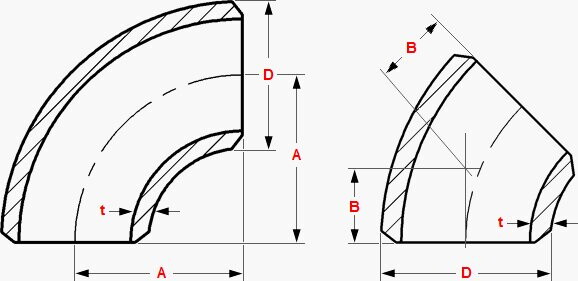Tips for Enhancing Stability of Welded Pipe Elbows
Posted: 02/21/2024 04:29:06 Hits: 7
Welded pipe elbows are integral components in diverse piping systems, where stability is paramount for safety and efficiency. Achieving and maintaining this stability requires a meticulous approach including various aspects of production, handling, installation and maintenance. In this article, we explore comprehensive measures aimed at enhancing the stability of welded pipe elbows, thereby optimizing their performance and extending their longevity.

1. Adherence to Stringent Production Processes
The production of welded pipe elbows demands strict adherence to rigorous manufacturing processes. It commences with meticulous material selection based on specified requirements, followed by precise cutting and shaping to meet curvature radius specifications. Heat treatment, including hot bending and post-bending shaping, plays a pivotal role in achieving desired configurations. Moreover, surface preparation through techniques such as shot blasting is crucial to eliminate oxidation and ensure proper adhesion during welding. Quality checks, including hydrostatic pressure testing, are imperative to validate compliance with standards before product dispatch.
2. Effective Corrosion Prevention and Preservation
Preserving welded pipe elbows from corrosion is essential for maintaining their stability and integrity over time. Proper storage practices are critical, shielding the elbows from corrosive elements such as salts and cementitious materials. Ideally, storage facilities should offer adequate ventilation and protection against direct exposure to rainwater, thereby minimizing the risk of rust formation. Regular inspection and cleaning of stored elbows are necessary to promptly address any signs of corrosion. While rust removal may seem labor-intensive, it is indispensable for ensuring optimal performance and longevity.
3. Safeguarding During Transportation
The transportation phase poses inherent risks of corrosion and damage to welded pipe elbows. Prior to shipment, elbows must be appropriately stacked according to specifications and securely packaged using plastic wrapping and outer casings to prevent physical damage and exposure to environmental elements during transit. Strict adherence to packaging standards mitigates the risks associated with transportation and ensures that elbows arrive at their destination in pristine condition.
4. Precise and Careful Installation
The stability of welded pipe elbows heavily relies on the accuracy and precision of their installation. Thorough verification of dimensions and alignment with engineering drawings is essential before commencing welding operations. Care must be taken to select the correct elbow for installation, avoiding inadvertent mismatches in size or specifications. Pre-installation inspection to validate the integrity of anti-corrosion coatings is imperative to prevent potential issues post-installation.
5. Regular Maintenance and Inspection
Once installed, welded pipe elbows require regular inspection and maintenance to detect and address any issues promptly. Periodic assessments of weld joints and surfaces for signs of corrosion or deterioration are essential. Timely intervention through cleaning and corrosion treatment minimizes the risk of structural degradation and ensures prolonged service life.
The production of welded pipe elbows demands strict adherence to rigorous manufacturing processes. It commences with meticulous material selection based on specified requirements, followed by precise cutting and shaping to meet curvature radius specifications. Heat treatment, including hot bending and post-bending shaping, plays a pivotal role in achieving desired configurations. Moreover, surface preparation through techniques such as shot blasting is crucial to eliminate oxidation and ensure proper adhesion during welding. Quality checks, including hydrostatic pressure testing, are imperative to validate compliance with standards before product dispatch.
2. Effective Corrosion Prevention and Preservation
Preserving welded pipe elbows from corrosion is essential for maintaining their stability and integrity over time. Proper storage practices are critical, shielding the elbows from corrosive elements such as salts and cementitious materials. Ideally, storage facilities should offer adequate ventilation and protection against direct exposure to rainwater, thereby minimizing the risk of rust formation. Regular inspection and cleaning of stored elbows are necessary to promptly address any signs of corrosion. While rust removal may seem labor-intensive, it is indispensable for ensuring optimal performance and longevity.
3. Safeguarding During Transportation
The transportation phase poses inherent risks of corrosion and damage to welded pipe elbows. Prior to shipment, elbows must be appropriately stacked according to specifications and securely packaged using plastic wrapping and outer casings to prevent physical damage and exposure to environmental elements during transit. Strict adherence to packaging standards mitigates the risks associated with transportation and ensures that elbows arrive at their destination in pristine condition.
4. Precise and Careful Installation
The stability of welded pipe elbows heavily relies on the accuracy and precision of their installation. Thorough verification of dimensions and alignment with engineering drawings is essential before commencing welding operations. Care must be taken to select the correct elbow for installation, avoiding inadvertent mismatches in size or specifications. Pre-installation inspection to validate the integrity of anti-corrosion coatings is imperative to prevent potential issues post-installation.
5. Regular Maintenance and Inspection
Once installed, welded pipe elbows require regular inspection and maintenance to detect and address any issues promptly. Periodic assessments of weld joints and surfaces for signs of corrosion or deterioration are essential. Timely intervention through cleaning and corrosion treatment minimizes the risk of structural degradation and ensures prolonged service life.
Improving the stability of welded pipe elbows requires a comprehensive approach covering all stages, from production to upkeep. Following strict manufacturing methods, using effective corrosion prevention techniques, protecting during transit, ensuring accurate fitting, and performing routine maintenance can greatly boost the stability and dependability of welded pipe elbows. These thorough steps not only enhance performance but also bolster the safety and efficiency of piping systems, underscoring the crucial role of stability in industrial settings.
Post URL: https://www.landeepipefitting.com/tips-for-enhancing-stability-of-welded-pipe-elbows.html
Landee is a professional industrial pipe fitting manufacturer and be well accepted by customers all over the world, we has been producing Pipe Fitting for a variety of applications since 1985. welcome to access our website: https://www.landeepipefitting.com.
Previous: Pressure Monitoring Instruments for High-pressure Pipe Fittings
Next: The Role and Advantages of Reducing Tees in Piping Systems
Next: The Role and Advantages of Reducing Tees in Piping Systems
